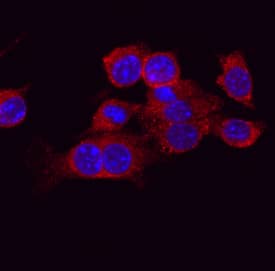ATG4A Products
The Autophagin protein family is involved in autophagy, the biological process in which endogenous protein and damaged organelles are degraded. ATG3 (autophagy-related protein 3; also known as APG3-like and PC3-96) is a ubiquitous 45 kDa member of the ATG3 family of proteins. It functions as an E2-like enzyme during the initial stages of autophagosome formation by catalyzing the transfer of ATG7-bound ATG8 (also known as LC3, GATE16 and GABA-RAP in mammals) to phosphatidylethanolamine, critical for autophagy.
ATG4A (Autophagy related protein 4 homolog A; also known as Autophagin 2) is a 50 kDa cytosolic cysteine protease mostly found in skeletal muscle and brain. ATG10 (autophagy-related protein 10; also known as APG10-like) is a ubiquitous 28 kDa member of the ATG10 family of proteins. It serves as an E2-like enzyme during the initial stages of autophagosome formation by catalyzing the transfer of ATG12 to ATG5. This ATG5:ATG12 heterodimer subsequently associates noncovalently with an ATG16 multimer to generate an autophagosome.
31 results for "ATG4A" in Products
31 results for "ATG4A" in Products
ATG4A Products
The Autophagin protein family is involved in autophagy, the biological process in which endogenous protein and damaged organelles are degraded. ATG3 (autophagy-related protein 3; also known as APG3-like and PC3-96) is a ubiquitous 45 kDa member of the ATG3 family of proteins. It functions as an E2-like enzyme during the initial stages of autophagosome formation by catalyzing the transfer of ATG7-bound ATG8 (also known as LC3, GATE16 and GABA-RAP in mammals) to phosphatidylethanolamine, critical for autophagy.
ATG4A (Autophagy related protein 4 homolog A; also known as Autophagin 2) is a 50 kDa cytosolic cysteine protease mostly found in skeletal muscle and brain. ATG10 (autophagy-related protein 10; also known as APG10-like) is a ubiquitous 28 kDa member of the ATG10 family of proteins. It serves as an E2-like enzyme during the initial stages of autophagosome formation by catalyzing the transfer of ATG12 to ATG5. This ATG5:ATG12 heterodimer subsequently associates noncovalently with an ATG16 multimer to generate an autophagosome.
| Reactivity: | Human, Mouse |
| Details: | Mouse IgG2b Monoclonal Clone #514914 |
| Applications: | WB, IP, ICC |
| Reactivity: | Human |
| Details: | Sheep IgG Polyclonal |
| Applications: | WB, IP |
Recombinant Monoclonal Antibody
| Reactivity: | Human, Mouse, Rat |
| Details: | Rabbit IgG Monoclonal Clone #SR1759 |
| Applications: | IHC, WB, IP |
| Reactivity: | Human, Mouse, Rat |
| Details: | Rabbit IgG Polyclonal |
| Applications: | IHC, WB |
| Reactivity: | Human, Mouse, Rat |
| Details: | Rabbit IgG Polyclonal |
| Applications: | IHC, WB, ELISA |
| Reactivity: | Human |
| Details: | Goat IgG Polyclonal |
| Applications: | IHC, ELISA |
| Applications: | AC |
| Reactivity: | Human, Mouse, Rat |
| Details: | Rabbit IgG Polyclonal |
| Applications: | IHC, WB, ELISA |
| Reactivity: | Human, Mouse, Rat |
| Details: | Rabbit IgG Polyclonal |
| Applications: | IHC, WB, ELISA |
| Reactivity: | Human, Mouse, Rat |
| Details: | Rabbit IgG Polyclonal |
| Applications: | IHC, WB, ELISA |
| Reactivity: | Human, Mouse, Rat |
| Details: | Rabbit IgG Polyclonal |
| Applications: | IHC, WB, ELISA |
| Reactivity: | Human, Mouse, Rat |
| Details: | Rabbit IgG Polyclonal |
| Applications: | IHC, WB, ELISA |
| Reactivity: | Human, Mouse, Rat |
| Details: | Rabbit IgG Polyclonal |
| Applications: | IHC, WB, ELISA |
| Reactivity: | Human, Mouse, Rat |
| Details: | Rabbit IgG Polyclonal |
| Applications: | IHC, WB, ELISA |
| Reactivity: | Human, Mouse, Rat |
| Details: | Rabbit IgG Polyclonal |
| Applications: | IHC, WB, ELISA |
| Reactivity: | Human, Mouse, Rat |
| Details: | Rabbit IgG Polyclonal |
| Applications: | IHC, WB, ELISA |
| Reactivity: | Human, Mouse, Rat |
| Details: | Rabbit IgG Polyclonal |
| Applications: | IHC, WB, ELISA |
| Reactivity: | Human, Mouse, Rat |
| Details: | Rabbit IgG Polyclonal |
| Applications: | IHC, WB, ELISA |
| Reactivity: | Human, Mouse, Rat |
| Details: | Rabbit IgG Polyclonal |
| Applications: | IHC, WB, ELISA |
| Reactivity: | Human, Mouse, Rat |
| Details: | Rabbit IgG Polyclonal |
| Applications: | IHC, WB, ELISA |
| Reactivity: | Human, Mouse, Rat |
| Details: | Rabbit IgG Polyclonal |
| Applications: | IHC, WB, ELISA |
| Reactivity: | Human, Mouse, Rat |
| Details: | Rabbit IgG Polyclonal |
| Applications: | IHC, WB, ELISA |
| Reactivity: | Human, Mouse, Rat |
| Details: | Rabbit IgG Polyclonal |
| Applications: | IHC, WB, ELISA |
| Reactivity: | Human, Mouse, Rat |
| Details: | Rabbit IgG Polyclonal |
| Applications: | IHC, WB, ELISA |
| Reactivity: | Human, Mouse, Rat |
| Details: | Rabbit IgG Polyclonal |
| Applications: | IHC, WB, ELISA |




![Western Blot: ATG4A Antibody (SR1759) [NBP3-21808] -](https://resources.bio-techne.com/images/products/nbp3-21808_rabbit-atg4a-mab-sr1759-57202317161834.jpg)
![Western Blot: ATG4A Antibody [NBP1-89044] Western Blot: ATG4A Antibody [NBP1-89044]](https://resources.bio-techne.com/images/products/ATG4A-Antibody-Western-Blot-NBP1-89044-img0006.jpg)
![Western Blot: ATG4A AntibodyBSA Free [NBP2-81788] Western Blot: ATG4A AntibodyBSA Free [NBP2-81788]](https://resources.bio-techne.com/images/products/ATG4A-Antibody-Western-Blot-NBP2-81788-img0001.jpg)
![Immunohistochemistry-Paraffin: ATG4A Antibody [NBP2-42518] Immunohistochemistry-Paraffin: ATG4A Antibody [NBP2-42518]](https://resources.bio-techne.com/images/products/ATG4A-Antibody-Immunohistochemistry-Paraffin-NBP2-42518-img0002.jpg)
